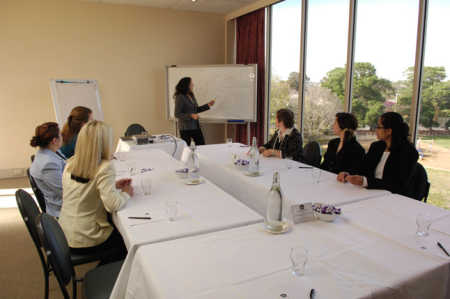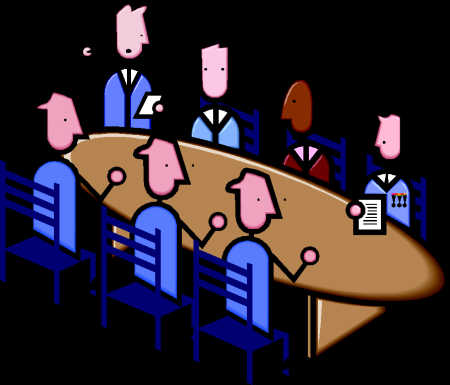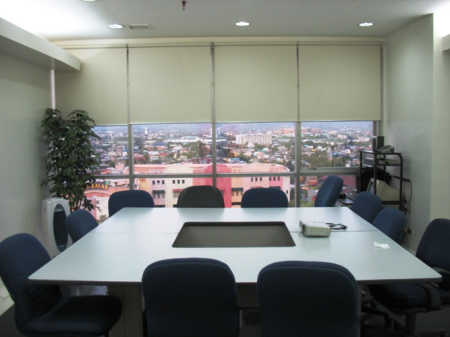Shyamal Majumdar in Mumbai
How many times have you been reminded of the need to stay on the "critical path" during company meetings? Hundreds of times, maybe even more.
Now, answer this question: what does the expression critical path mean to you? There's no need to worry even if you don't know the answer.
Chances are that your teammates in those meetings or even the person who has been reminding you about it are as clueless. Critical path is just one among many meaningless catchwords that are used in company meetings all over the world.
An HR manager, who has recently been given the additional responsibility of being a "meeting facilitator", says his brief experience has been an eye-opener.
Here's how to make boardroom meetings meaningful...
Image: Managers call meetings to pass on messages that could just as easily have been sent by email.He looked at the work-calendars of many senior managers and noticed they were completely full, with quite a few double bookings to boot.
But the HR manager thinks most of these meetings are meaningless babble and end up filling whiteboard after whiteboard with incomprehensible flowcharts.
Often, managers call meetings to pass on messages that could just as easily have been sent by email, or to rubber-stamp decisions they have already taken.
The HR manager recalls a senior manager calling a meeting of a few of his juniors simply because he had an hour to spare before his next meeting.
Here's how to make boardroom meetings meaningful...
Image: Impromptu meetings are usually known as brainstorming sessions with no real agenda.But the meeting went like this: "So, what's happening, folks?" the boss asked.
"Everything is fine, sir," was the unanimous response.
"So, how do we improve our performance?" was the next question.
The response ranged from having better toilets and computers to "we need more people" to increasing salaries and so on.
All this while the boss kept his eyes on his BlackBerry Messenger before ending the meeting abruptly. Such impromptu meetings are usually known as brainstorming sessions with no real agenda. These are forums for a relaxing flow of random thoughts without ever reaching a decision.
Here's how to make boardroom meetings meaningful...
Image: Over 95 per cent of meetings are useless.The HR manager-cum-meeting facilitator says he has tried an exercise suggested by a blog in the website fastcompany.com and has been amazed by the insight.
The suggestion is as follows: Do you keep falling asleep in meetings and seminars? Here's a way to change all of that.
"Before (or during) the next meeting, prepare yourself by drawing a square. A 5" x 5" is a good size. Divide the card into columns - five across and five down. That will give you 25 one-inch blocks.
Then, write one of the following words/phrases in each block: Synergy, strategic fit, core competencies, best practice, bottom line, revisit, expeditious, to tell you the truth (or "the truth is"), 24/7, out of the loop, benchmark, value-added, proactive, win-win, think outside the box, fast track, result-driven, knowledge base, at the end of the day, touch base, mindset, client focus(ed), paradigm, game plan, leverage, and so on.
Here's how to make boardroom meetings meaningful...
Image: This is not to say meetings aren't required.Now check off the appropriate block when you hear one of those words/phrases. When you get five blocks horizontally, vertically, or diagonally, stand up and shout!"
The HR manager isn't sure about the "shouting" part since that may cost you your job, but says the exercise has helped him gauge the efficacy of meetings.
According to his calculations, over 95 per cent of meetings are useless. This is not to say meetings aren't required. They obviously serve a useful purpose, provided you have fewer meetings and make the ones you hold efficient.
The bright people you have may simply not want to waste their talents listening to management teams talking to hear their own voices.
Here's how to make boardroom meetings meaningful...
Image: Meetings should have a clear agenda with specific items.The best way this can be done is to ensure that all meetings have a clear agenda with specific items and call only those people who are required.
Often, companies make the mistake of calling a bunch of people who have nothing to do with the meeting's agenda. It's like this: there is no point CC'ing a bunch of other team members on an email they could easily skip.
The only purpose such CC'ing serves is to jam everybody's inbox and force people to press the delete button. Some meetings just go on and on - you would earn the eternal gratitude of your team members if you set a specific time for a meeting.
Here's how to make boardroom meetings meaningful...
Image: If the agenda is over ahead of time, don't hesitate to end the meeting earlier.If the agenda is over ahead of time, don't hesitate to end the meeting earlier. If you are an efficient CEO, reserve some time for chit-chats as well. They may look like a waste of time, but often serve a useful purpose.
Research has shown that people often open up more during casual conversations and come up with workable ideas. As a CEO, there is no better way to size people up than in the first few minutes, before they have adopted their formal roles and have started going into a more scripted mode.
Here's how to make boardroom meetings meaningful...
Image: Also, insist on a written note on what transpired during the meeting.Also, insist on a written note on what transpired during the meeting, along with a list of actions that named individuals have agreed to perform. It helps.
Finally, to help you determine the objective of your meeting, complete this sentence: "At the close of the meeting, I want the group to..."
If you can complete the sentence with conviction, you would have helped a lot of your colleagues get over what is known as meeting sickness.










article